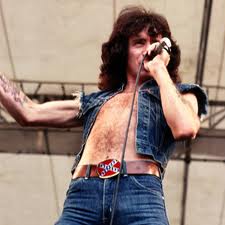 The 19th of this month saw the 32nd anniversary of the death of Bon Scott, the frontman who helped turn a little guitar band called AC/DC from Sydney, Australia into one of the greatest rock outfits in the world. Now, I’m not about to write a biography of the man’s tragically short life – there are plenty of those already in existence – but I am going to explain briefly why to me, he was (and remains) possibly the greatest rock lyricist ever.
The 19th of this month saw the 32nd anniversary of the death of Bon Scott, the frontman who helped turn a little guitar band called AC/DC from Sydney, Australia into one of the greatest rock outfits in the world. Now, I’m not about to write a biography of the man’s tragically short life – there are plenty of those already in existence – but I am going to explain briefly why to me, he was (and remains) possibly the greatest rock lyricist ever.
I was fourteen years old when, like many teenagers, I came upon the notion that my parents weren’t cool and so I began trying hard not to become like them. One of the ways I attempted to achieve this was via music and this was very easy because I’d been brought up on a strict diet of classical. “Top Of The Pops” only ever appeared on our TV by accident and it was off again as quickly as my father could get out of his chair and push another button. To him, anything louder than Sinatra was an abomination and so to me, rock music seemed like the perfect antidote.
Therefore, with a few quid in my pocket and the name of a band (whom I knew virtually nothing about) in my head, I went to my local record store and bought a cassette tape of AC/DC. I distinctly remember it was “If You Want Blood” because I thought the album cover was amazing. Feeling like a total rebel, I smuggled it home and later in the privacy of my bedroom I pressed play on my puny little mono tape recorder and listened as this amazing new sound thrilled me. And so began a passion with a genre that defined my youth.
With the passing of years, musical taste tends to change or perhaps “develop” would be a better word and while my music library still holds a large percentage of rock, I’m quite happy to admit that it now includes many other genres. However, if I were to ever find myself in a “Desert Island Disc” sort of scenario, I can honestly say without a moment’s hesitation that Bon Scott would feature somewhere in that essential collection.
Certain tracks that I’ve been listening to since those teenage years still make me want to stop whatever it is I’m doing so that I can concentrate on Bon’s clever and often hilarious lyrics. Yes, there was no question the man had a sense of humour. “Big Balls” and “Up To My Neck In You” are two examples showcasing that. I defy anyone to listen to the former and not laugh out loud! And there was also no question what occupied his dirty little rock n roll mind a lot of the time. Just listen to “Squealer” or “Love At First Feel” and you’ll be left in no doubt. He truly was a master of the double entendre – possibly matched only by Steven Tyler of Aerosmith. But Bon created characters too that could scare or amuse us or come alive in our minds as someone we’re perhaps familiar with or can relate to. “Prowler”, “Dirty Deeds Done Dirt Cheap” and “Sin City” are three that do just that. I could go on giving examples but you’d be much better off playing the music and experiencing his talent rather than reading about it. The fact is, Bon didn’t just have talent, he had charisma – bags of the stuff – and it was evident in his songwriting and his performance. How many rock stars can we truly say that about?
I’m still a big fan of AC/DC and I think Brian Johnson, who picked up the gauntlet (or should that be microphone) in 1980 following Bon’s death, has done a tremendous job of leading the band into the new century. Their last album “Black Ice” was to my mind one of their best since the early 80s. I love the fact that all the band’s CDs are still available in music stores; it’s clear their music continues to find new audiences. And it’s obvious why – as a rock band, they are one of the originals and have very few peers and as a singer/songwriter, Bon Scott was a rock n roll genius. I’ve no doubt whatsoever that each new generation of rock fan will discover him and come to realise the wonderful ability he had and for me that proves one thing; death is not the end.

